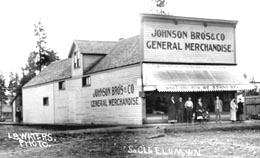On August 28, 1911, the town of South Cle Elum in Kittitas County is incorporated. The town, across the Yakima River from the larger town of Cle Elum, had sprung into existence in 1908 when the Chicago, Milwaukee, and St. Paul Railroad (the Milwaukee Road) arrived and built a depot, roundhouse, and rail yard. South Cle Elum immediately became a bustling rail center and division point. Three years later residents vote to incorporate as a town of the fourth class, and the Washington Secretary of State makes it official on August 28.
From Farmland to Incorporated Town
The site of South Cle Elum was farmland before the Milwaukee Road announced that its route would run up the opposite side of the Yakima River from the long-established town of Cle Elum (and the rival Northern Pacific Railroad line). Once the Milwaukee Road arrived in 1908, South Cle Elum instantly grew up around its depot and tracks. The incorporation vote reflected a desire for autonomy from the bigger town across the river.
In the election held on July 26, 1911, the incorporation measure passed by a vote of 92 to 34. Voters also chose R. F. Adams as the first mayor and elected the first town council: J. A. Fless, J. T. Mitchell, W. O. Clark, D. F. Ford and H. F. Hardin. T. J. Denny was elected the first treasurer. The Kittitas County commissioners certified the vote on August 5, 1911.
The council had its first informal meeting on August 23, 1911, in the Johnson Brothers store. Then it held its first regular session on August 25, 1911, at Leidell's Hall -- three days before the Secretary of State even made incorporation official. The council hired a town attorney, a health officer, and a marshal. In 1912, the council authorized construction of the first town hall and jail, at a total cost of $1,318. The council first met in the new town hall on November 18, 1912.
South Cle Elum remained a key station on the Milwaukee Road for the next seven decades. However, in 1980, the Milwaukee Road abandoned the route. The restored depot and rail yards later became part of Iron Horse State Park and a popular destination for rail buffs.

